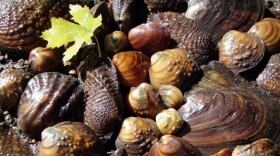Did you know that one of our most Clark Kent-like Northwoods plants has a Superman power? Tag Alder is a scruffy shrub, often forming a thicket of stems that sprawl over stream and lake edges. If you are trying to walk along a shoreline or stream bank, tag alder will force you to get your feet wet and wade to get past them. Though it may be a nuisance in some situations, tag alder has a magic trick – it can fix nitrogen. Oh, you don’t think that is all that great? Well, it is truly an amazing talent.
A quick chemistry tutorial: Plants and all living things need nitrogen – it is a critical ingredient in proteins and other compounds in your body. And air is 78% nitrogen so what is the problem? The problem is that nitrogen as it exists in air is made of two nitrogen atoms triple bonded together and is just about the strongest bond that exists in nature and is extremely hard to break. Plants cannot use nitrogen in this form and can only use nitrogen once it is chemically altered into ammonia. Converting nitrogen gas to ammonia is called nitrogen fixation. Aside from the occasional conversion by lightning, the only other way nitrogen gas can be converted to usable ammonia is by the action of certain bacteria.
That is, until scientists Fritz Haber and Carl Bosch, German scientists, figured out how to convert nitrogen gas into ammonia in the first decade of the 20th century. At this time, there was a great demand for nitrates for use as fertilizers to increase food production. In the Haber process, nitrogen gas from the air is mixed with hydrogen and water at high temperatures to produce ammonia. The ammonia is then turned into nitric acid and from there into nitrates, which are then used as fertilizers. Industrial-produced fertilizers were extraordinarily important in increasing food production around the world.
But nitrates also have a dark side. They are a key ingredient in bombs, and the invention of the Haber process just before World War 1 helped the Germans out of a jam. Sodium nitrate, a naturally occurring compound also known as saltpeter is another source of nitrates and was found in the Atacama Desert in Chile. Germans would have liked to import it but at this time, the British controlled the shipping lanes and deprived Germany of access to this resource from South America. So the Haber process producing ammonia from nitrogen gas was critical to the German bomb production in World War 1. If not for the Haber process, Germany likely would have lost their bomb-making ability within a few months. In the century since its discovery, there have been refinements to the Haber process, but the basic chemical reactions are still used today. It is estimated that about half the nitrogen your body came from the Haber process, and for better or worse, is largely responsible for the huge population growth since its development.
Plants that can fix their own nitrogen are basically fertilizing themselves and should be at a huge advantage over other non-nitrogen fixing plants. Aside from alder I mentioned before, there are other biological organisms that can also fix nitrogen. About half of all cyanobacteria, also known as blue green algae, can fix nitrogen but they live in fresh water and the oceans. Many plant species in the pea family, including soybeans, peanuts and clover, can also fix nitrogen. These plants, as well as alder have little bumps, called nodules, on their roots that house special bacteria that can carry out nitrogen fixation.
So it seems like every plant on earth ought to hook up with some friendly nitrogen-fixing bacteria and provide themselves with an abundant supply of usable nitrogen. Why can alder, as well as two other Northwoods plants, sweet gale and sweet fern, fix nitrogen while relatively few plants around the world can do it? There appear to be several main reasons. First, it is energetically expensive to the plant to support the bacteria in the root nodules that fix nitrogen. So, plants must generate enough sugar through photosynthesis to support this expensive habit. Second, to be able to photosynthesize enough, they need lots of sunlight and can’t grow anyplace shady. Third, the bacteria in the nodules need a no-oxygen environment, and this is not usually conducive to good growth. But this works well for alder and sweet gale, since they grow on the water’s edge with plenty of light and their roots are probably in water-logged and oxygen-deprived soil.
In the end, not all plants solve all their challenges in the same way.
As the economist Thomas Sowell said, “There are no solutions. There are only trade-offs.”









